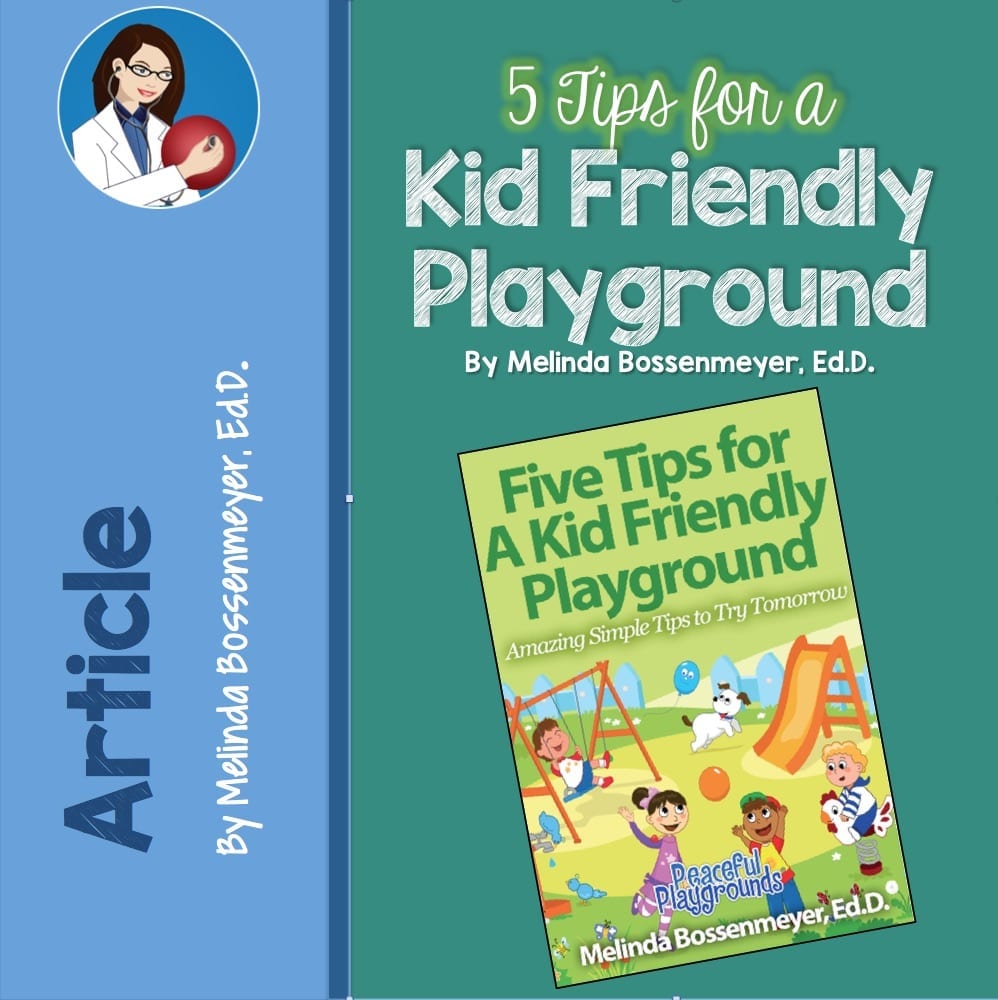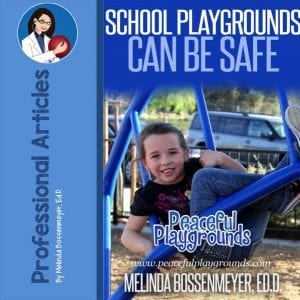5 Tips for a Kid Friendly Playground
By Dr. Melinda Bossenmeyer, The Recess Doctor

5 Tips for a Kid Friendly Playground
Peaceful Playgrounds shares Five Tips for a Kid Friendly Playground based on their research on playgrounds. These 5 easy to implementation tips can make a big difference in kids feeling safe on the playground.
I watched a less popular girl, Allison, walk up to a group of four girls who were playing a game of four-square. As she approached and asked, "Can I play?" she was quickly rebuffed. "The game is closed," Janey, the ring leader, announced.
Given the school is a Peaceful Playgrounds' school, I was surprised at the response because of the "You can't say, 'You can't play'" mantra. Allison, whose disappointment was obvious, turned to play another game. Fortunately, the playground was filled with alternate game choices and two other four-square courts. Allison selected one of those courts and soon was happily involved in another four-square game. This time she didn't ask, but rather waited in line by the letter D.
Permission. Is it a good idea?
It was an interesting observation for a number of reasons. I began to dissect what happened and why. In the first situation, Allison asked for permission to play. The question, "Can I play?", allowed Janey the opportunity to respond and in fact, reject the request.
In the second situation, Allison simply stood in line and waited her turn. No one challenged her right to play. She didn't ask permission but rather followed the rules of the playground and when her turn came she merely stepped onto the court. No one challenged her right to do so.
Entwined within the actions of young children was a lesson. When you act in accordance with the school rules (wait in line and go in when appropriate), that behavior makes rejection less likely.
Exclusion is not always playground bullying
I've been working on an online bullying prevention course for school staff, which meets state requirements for staff training. This reminded me of what I've been writing about, the ways in which girls bully. Girls typically get involved with indirect types of bullying, for example, nasty staring, spreading rumors, manipulating friendships, and excluding peers. The four girls who turned Allison away all participated in Janey's decree of "You can't play." However, it wasn't bullying as typically described, because there was no mention of a power differential. The intent to hurt was questionable. Although it didn't meet the classic criteria for bullying, the activity was still hurtful, as evidenced by Allison's reaction. Read below to find out how this situation might be addressed in a more "kid-friendly manner."
1. Establish playground, rules, procedures, and high expectations.
Playground markings and choice help make the playground emotionally safe.
Why didn't Allison remind them of the school rule, "You can't say, 'You can't play'"? I'm not sure. If that had been the only four-square court, perhaps she would have. This illustrates the importance of painting multiple markings of the same court. When we gathered information about children's play choices, we observed that children often picked a less preferred game rather than wait in line on a Peaceful Playground. This scenario is likely played out daily on numerous times on playgrounds all across America. Below are a few key points that address this situation, relating to some of the philosophies and procedures in the Peaceful Playgrounds Program. The statements below explain some of the rules and procedures and the philosophy behind them.
2. You can't say, you can't play.
Whether or not a child invokes this rule, it illustrates the notion that all kids get to play all games. This simple rule makes a big difference in the emotional culture of the playground. Exclusion is something that is hurtful and sometimes crosses over into a form of bullying, especially in girls.
3. Multiple playground markings.
Peaceful Playgrounds advocates painting multiple games of the same marking. For the reason illustrated in the situation above, if children want to play a particular game, they will have options. Multiple playground markings make exclusion less likely when children have the choice of which game they will choose to play on and perhaps even start a new game that may include other children. We recommend a minimum of three courts for each activity.

4. Pick an alternate game rather than waiting in line.
We have found that multiple game markings are important not only for the reason expressed above but also because it eliminates or reduces the number of time students wait in line. We observed that rather than waiting in line children select a less preferred game most of the time. For example, if 4-square is my first choice of activity and the courts are all full of lines, then the child may choose a long ball which is a similar game but with no line.
5. Letting children solve problems on the playground.
We have operated under the philosophy that the playground is an opportunity for students to practice what they may face in life. Sometimes people may choose not to engage with certain people. The rejection on the playground or the ability to maneuver when faced with rejection is a life skill that needs to be developed. Sometimes the hard reality of life is that we are excluded. Supporting the excluded child or establishing the "You Can't Say, You Can't Play" rule are both ways of assisting the child while still expecting the child to learn how to deal with a difficult situation. However, repeated rejection is not appropriate and the situation should be evaluated for bullying criteria to see if it falls into that discipline domain.
Melinda Bossenmeyer, Ed.D. is an expert witness for school supervision, playground injury cases, physical education, and coaching cases related to supervision. Professional articles by Dr. Bossenmeyer © Peaceful Playgrounds 1998 All Rights Reserved
Related Articles
Peaceful Playground Program & Professional Articles
Five Tips for a Kid Friendly Playground
"*" indicates required fields






